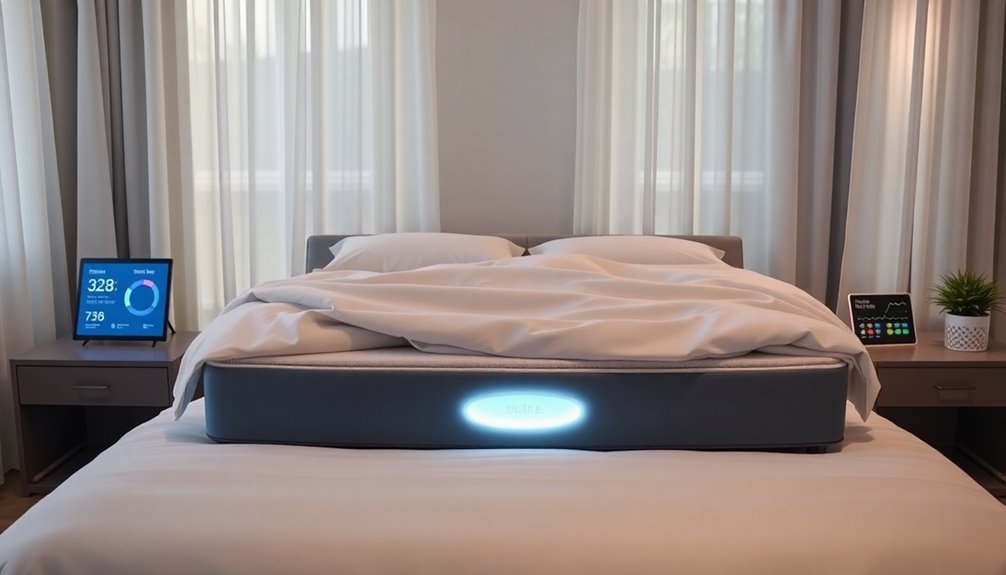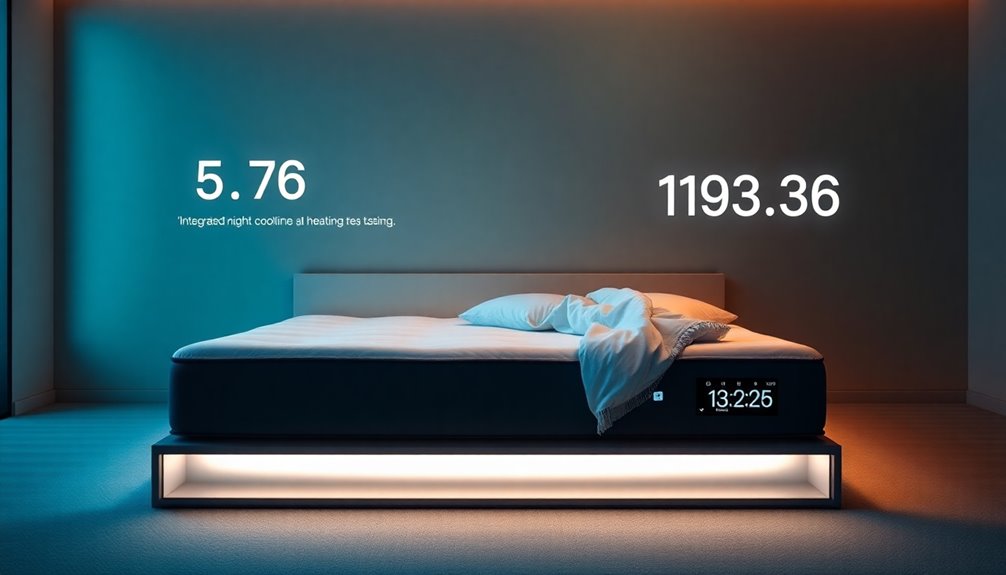The Eight Sleep bed is a game-changer for your nightly rest. With dual-zone temperature management, you can customize the bed's climate from 55°F to 110°F, ensuring both you and your partner sleep comfortably. Its advanced sleep tracking technology monitors your heart rate and breathing, while the intelligent autopilot adjusts the temperature throughout the night based on your sleep stages. Enjoy the gentle wake-up call of the GentleRise Smart Alarm, and listen to the impressive user feedback—many report a significant improvement in sleep quality. You'll be amazed at how it enhances your rest; more is waiting to be uncovered.
Key Takeaways
- Experience personalized comfort with dual-zone temperature management, allowing individual settings for each side of the bed.
- Benefit from advanced sleep tracking technology that monitors heart rate, breathing, and sleep stages for insightful health data.
- Enjoy improved sleep quality, with users reporting a 32% enhancement in sleep after just one month of use.
- Utilize the GentleRise Smart Alarm, which gradually wakes you with gentle vibrations or temperature changes for a more pleasant morning.
- Take advantage of customizable routines and integration with health apps for a comprehensive sleep management experience.
Key Features of Eight Sleep

Eight Sleep offers several key features that elevate your sleep experience. One standout feature is the dual-zone temperature management, which lets you and your partner set independent temperatures for each side of the bed, ranging from 55°F to 110°F. You can easily adjust the temperature on a scale of 1 to 10, catering to your personal comfort preferences. The autopilot system smartly adjusts the bed's temperature based on your sleep stages, ensuring you stay cozy throughout the night.
Additionally, the gentleRise Smart Alarm gradually wakes you using either vibration or temperature changes, so you're not jolted awake. You can customize wake-up temperatures, creating a more natural start to your day without disturbing your partner. The integration of biometric tracking allows you to monitor your heart rate, breathing, and sleep stages, providing valuable insights into your overall sleep health.
The design of Eight Sleep is compatible with existing bed frames and mattresses, enhancing your current setup without hassle. Its invisible sensing technology utilizes double sensors for improved accuracy, while device-free controls make operation seamless. With clinical-grade sensors, it provides accurate sleep metrics, helping you understand your sleep patterns better. Overall, these features work together to transform your nightly routine into a more restful and rejuvenating experience.
Advanced Sleep Tracking Technology

Advanced sleep tracking technology is revolutionizing how you understand and optimize your sleep. With a sophisticated network of sensors, your bed continuously monitors vital metrics like heart rate, breathing rate, and sleep stages. This data integration, including full polysomnography, validates your sleep patterns and provides real-time insights into your physiological state.
The system employs advanced deep learning algorithms, trained on over 5,700 subjects, enhancing accuracy by 50% compared to traditional models. These algorithms not only analyze your sleep but also dynamically adjust the bed temperature based on your sleep stages, ensuring a comfortable night's rest. Research indicates that adults require 7-9 hours of sleep for optimal functioning, a guideline the technology helps you achieve.
Predictive analytics take it a step further by offering personalized recommendations, considering your unique demographics and health conditions. This tailored approach helps you improve your sleep quality and provides insights into your overall sleep health, including restlessness and recovery.
Enhanced User Experience With App

In today's fast-paced world, enhancing your sleep experience is easier than ever with the new app interface. The Home screen gives you a bird's eye view of everything, featuring shortcuts to temperature settings and routines for quick adjustments. You'll find four main tabs—overview, scheduled temperatures, alarms, and sleep tracking—making navigation simple and intuitive.
Customization is key, allowing you to set routines that help maintain sleep consistency with personalized bedtime and alarm settings. You can fine-tune temperature controls and train Autopilot to remember your preferences. If you share your bed, the Multi-Pod support lets you manage both yours and your partner's settings seamlessly. Additionally, the app's smart alerts system ensures you're promptly notified of any maintenance needs, enhancing your overall experience.
The app also includes a smart alerts system, notifying you of maintenance needs like priming or refilling. With improved reliability and speed—loading twice as fast—you won't experience frustrating crashes or bugs. Plus, device-free controls let you adjust settings directly from the bed.
The Gentle Rise alarm feature wakes you gently with vibrations and thermal changes, ensuring a smooth start to your day. With seamless integration with health apps like Apple Health, your sleep experience just got a high-tech upgrade.
Proven Benefits and Statistics

The benefits of using the Eight Sleep Pod are backed by impressive statistics that highlight its effectiveness in enhancing sleep quality and overall well-being. After just one month of use, you can expect your sleep quality to improve by an average of 32%. You'll fall asleep faster, with sleep onset time reduced by 44% and interruptions decreasing by 23%. As a result, your daytime energy levels could increase by 34%.
In terms of deep sleep and REM sleep, you'll notice significant enhancements. On average, deep sleep increases by 10%, and those who initially struggled with deep sleep can see improvements of up to 34%. Individuals with initially low deep sleep can experience the most substantial benefits, reinforcing the importance of this phase of sleep. You'll also enjoy between 2 to 3.5 hours of REM sleep, compared to just 1 to 2 hours previously.
The Pod also promotes cardiovascular health, with an average decrease in sleeping heart rate by 1% and increased heart rate variability by 6%. You might even experience a notable 3.2% reduction in mortality risk due to these changes. Lastly, users often engage in 8% more moderate-intensity exercise and 65% more high-intensity workouts, reinforcing the positive link between sleep quality and physical activity levels.
Overview of Product Line

Having explored the impressive benefits of the Eight Sleep Pod, it's clear that this innovative sleep solution stands out in its product line. The Eight Sleep Pod Series features several models, each designed to enhance your sleep experience.
Starting with the Pod 3, you'll enjoy individualized heating and cooling, along with advanced health tracking and thermal alarms. The Pod 4 takes it a step further, offering faster cooling, better temperature uniformity, and a quieter operation—40% quieter than its predecessor. If you're looking for the ultimate experience, the Pod 4 Ultra includes an adjustable base, snore reduction features, and convenient tap zones for control.
All models incorporate Active Grid Technology for optimal firmness and temperature regulation, supported by clinical-grade sensors that accurately track your sleep metrics. Plus, these beds can fit with existing frames or serve as replacements, giving you flexibility.
With a user-friendly app, you can easily manage your bed's settings, ensuring your comfort is just a tap away. Each model also comes with a 100-night trial and warranties, allowing you to experience the transformation risk-free.
Business and Market Strategy

Navigating the competitive landscape of sleep technology requires a strategic approach that emphasizes premium branding and innovative product offerings. You'll want to target health-conscious consumers, particularly millennials and bio-tracking users, who are eager for high-end sleep solutions. By positioning your products as luxurious and technologically advanced, you can attract a demographic willing to pay premium prices.
To fund continuous research and development, consider implementing subscription models. This will not only enhance your revenue but also allow you to maintain high-quality standards with more sensors and features. As you establish a reputation, gradually reduce prices for mass-market versions of your products to capture a broader audience.
Expanding your product line is essential. Incorporate complementary items like lights, sound, and scent devices to create a comprehensive sleep ecosystem. Additionally, partnerships with popular platforms, like Strava, can raise brand awareness and generate new revenue streams. Eight Sleep integrates multiple sensors into bedding for comprehensive data collection to create a more personalized experience for users.
With the sleep technology market projected to grow significantly, your long-term vision should focus on becoming a predictive health platform, much like Tesla's evolution. This strategic foresight will position you at the forefront of the industry, ensuring sustained success.
Integration With Health Platforms

Integrating your high-tech bed with health platforms can dramatically enhance your sleep experience by providing a holistic view of your well-being. With seamless data sharing between Eight Sleep and Apple Health, you gain access to your sleep stages, heart rate, and daily activity metrics. This comprehensive data syncs automatically, ensuring your insights remain up to date. By granting permission for data sharing, you unlock personalized sleep recommendations tailored to your unique patterns.
Moreover, Eight Sleep supports multiple wearables like Apple Watch and Fitbit, offering over 40 data points to analyze your sleep quality. The Terra API simplifies connections, allowing you to merge your wearable data with sleep metrics for a more detailed health overview. Additionally, syncing with Apple Health combines data from both platforms for a more comprehensive health analysis, giving you deeper insights into your overall wellness.
Integrating with other health apps such as Peloton and WHOOP provides insights into how workouts impact your recovery and sleep cycles. Utilizing health-grade sensors, Eight Sleep tracks your body movements and biometrics, ensuring accuracy in your sleep data. This integration not only improves sleep quality but also enhances recovery by adjusting bed temperature based on your activity levels. With a comprehensive approach to health monitoring, you can truly optimize your sleep and overall wellness.
Customer Testimonials and Reviews

What do users really think about the Eight Sleep Pod? Many rave about the improved sleep quality, citing fewer wake periods and more time spent in deep and REM sleep. If you're a hot sleeper, you'll appreciate how the temperature control adjusts throughout the night to keep you comfortable. However, some users find the setup process a bit frustrating, particularly with the Priming sessions and Hub-related issues.
While the Pod can make your mattress feel firmer, this might not suit everyone’s preference. That said, overall satisfaction remains high, with many recommending it for its sleep-enhancing features. Users love the Autopilot program that customizes temperatures based on their biometric data, leading to better sleep consistency and improved schedules. The dual temperature control is a hit, allowing partners to set their own preferences. Additionally, many users have reported experiencing increased durations of deep and REM sleep, which are crucial for restorative rest. Understanding the importance of emotional regulation can also enhance the overall experience during sleep transitions. Furthermore, establishing a routine for relaxation can significantly contribute to improved sleep quality and emotional health. Many users have also integrated tranquil spa room ideas into their sleep environments, creating serene spaces that further promote relaxation and restful sleep. By incorporating elements such as soft lighting, soothing scents, and comfortable bedding, individuals can enhance their overall sleep experience even more. These thoughtful additions, combined with the benefits provided by the Pod, can lead to deeper relaxation and rejuvenation during the night.
On the flip side, customer support experiences vary. Some report delays and challenges with warranty claims, but others have praised the immediate live chat support during setup. The price is a significant consideration, but many users feel the investment is justified due to the substantial impact on their sleep health.
Frequently Asked Questions
How Does Eight Sleep Handle Temperature Preferences for Couples?
When it comes to temperature preferences for couples, you can easily customize your side of the bed. With a dual-zone feature, you and your partner can set individual temperatures through an app, ensuring both of you sleep comfortably. The system even makes automatic adjustments based on your sleep cycles and body temperatures, catering to your unique needs throughout the night. This way, you both enjoy restful sleep without any temperature conflicts.
Can I Use Eight Sleep Without the App?
You can't effectively use the Eight Sleep system without the app. While you might manage some basic functions through tap zones, detailed settings and full customization are app-dependent. The app handles temperature control, sleep tracking, and maintenance alerts, making it essential for proper setup and operation. Without it, you'll miss out on advanced features and personalized insights that enhance your sleep experience. So, make sure you have the app for optimal functionality.
What Is the Warranty Period for Eight Sleep Products?
The warranty period for Eight Sleep products varies. The foam layer comes with a 10-year limited warranty, covering defects like foam deterioration. For technology components, the Smart Bed has a 1-year warranty, while the Pod models offer 2 years. You can also opt for an extended warranty through an Enhanced subscription for up to 5 years. Remember, certain conditions and exclusions apply, so make sure you understand them to keep your warranty valid.
Are There Financing Options Available for Purchasing the Bed?
Yes, there are financing options available for purchasing the bed. You can choose to pay in 4 interest-free installments through Sezzle or opt for Affirm's plans that range from 12 to 36 months. Both options offer flexible terms without hard credit checks, allowing you to manage your budget comfortably. Plus, you'll have access to a trial period and warranty, ensuring you make a well-informed decision about your purchase.
How Often Do I Need to Clean the Eight Sleep Mattress?
You should clean the Eight Sleep mattress cover regularly to maintain hygiene. Wipe it down with a damp cloth and mild detergent every couple of weeks, avoiding harsh chemicals. Every 2 to 3 months, drain and refill the water system to prevent bacteria growth. Inspect the components and keep the area around the mattress clean. If needed, sprinkle baking soda to eliminate odors and vacuum it off for a fresh feel.
Conclusion
With Eight Sleep, you're not just upgrading your bed; you're transforming your entire sleep experience. Its advanced tracking technology and user-friendly app help you optimize your rest like never before. Plus, the positive testimonials and proven benefits show real results. Whether you're looking to enhance your nightly routine or improve your overall health, Eight Sleep offers an innovative solution. Don't just dream about better sleep—make it a reality with this high-tech bed upgrade.









